INTENSIVE UCATION FOR INFANTRY CFIANIZATION
Page 26
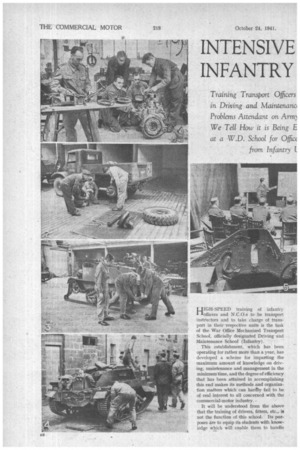
Page 27
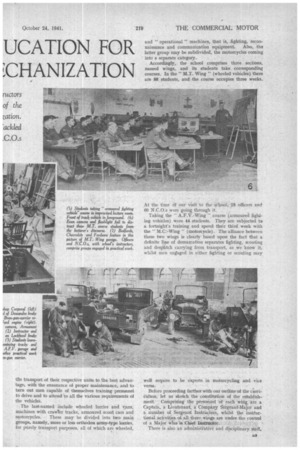
Page 28
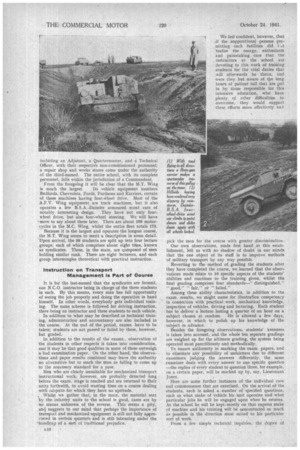
Page 29
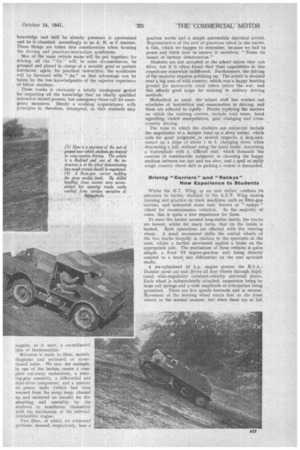
Page 30
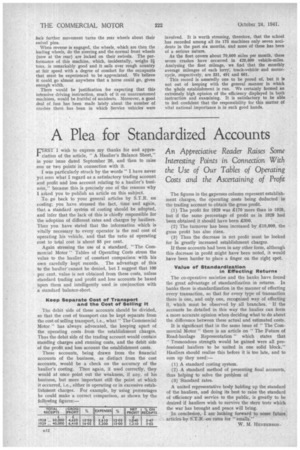
If you've noticed an error in this article please click here to report it so we can fix it.
HIGH-SPEED training of infantry 'officers and N.C.O.s to be transport instructors and to take charge of transport in their -respective units is the task of the War Office Mechanized Transport School, officially designated Driving and Maintenance School (Infantry).
This establishment, which has been operating for rather more than a year, has developed a scheme for imparting the maximum amount of knowledge on driving, maintenance and management in the minimum time, and the degree of efficiency that has been attained in accomplishing this end makes its methods and organization matters which can hardly fail to be of real interest to all concerned with the commercial-motor industry.
It will be understood from the above that the training of drivers, fitters, etc., is not the function of this school. Its purposes dre to equip its students with knowledge which will enable them to handle tRe transport of their respective units to the best advan'tage$ with the ensurance of proper mainteriant:e, and to turn out men capable of themselves training personnel to drive and to attend to all the various requirements of the vehicle's.
The last-rtanted include wheeled lorries and vans, machines with crawrer tracks, armoured scout cars and motorcycles. These may be divided into two main groups, namely, more or less orthodox army-type lorries, for purely transport purposes, all of which are wheeled, and " operational " machines, that is, fighting, recon naissance and communication equipment. Also, the latter group may be subdivided, the motorcycles coming into a separate category.
Accordingly, the school comprises three sections, named wings, and its students take corresponding courses. In the " M.T. Wing " (wheeled vehicles) there are 88 students, and the course occupies three weeks.
At the time Of our visit to the school; -28 officers and GO N.C.O.s were going through it.
Taking the " A.F.V.-Wing "coarse (armoured fighting vehicles) were 44 students. They are subjected to a fortnight's training and spend their third week with the " M.C:sWing " (motorcycle). The affiance between these two wings is clearly based upon the fact that a definite line of demarcation separates fighting, scouting and despatch carrying from transport, as we know it, whilst men engaged in either fighting or scouting may well require to be experts in motorcycling and vice versa.
Before proceeding farther with our outline of the curd,. Oblum, let us sketch the constitation of the establishment. Comprising the perSonnel of each wing are a Captain, a Lieutenant, a Company etgeantMajot and a number of .Sergearit'InStrnetors,. whilst the instfactonal activities of all three. wings are under the control
of a Major who is Instnrietor.
There is also an administrative and disciplinary staff,
including an Adjutant, 'a Quartermaster, and a Technical Officer, with their respectiVe non-commissioned personnel; a repair shop and works stores come under the authority of the third-named. The entire school, with its complete personnel, falls within the jurisdiction of a Commandant. .
From the foregoing it will be clear that the M.T. Wing
is much the largest. Its vehicle equipment numbers Bedfords, Chevrolets, Fords, Fordsons and Karriers, certain of these machines having four-Wheel drive. Most of the A.F.V. Wing equipment are track machines, but it also operates a few B.S.A.-Daimler armoured scout cars of notably interesting design. They have not only fourwheel drive, but also four-wheel steering. We will have • more to say about these later. There are about 100 motorcycles in the M.C. Wing, whilst the entire fleet totals 175. Because it is the largest and operates the longest course, the M.T. Wing seems to merit a description in some detail. Upon arrival, the 88 students are split up into four lecture groups, each of which comprises about eight trios, known as syndicates. These, in the main, are composed of men holding similar rank. There are eight lecturers, and each group intermingles theoretical with practical instruction. .
Instruction on Transport Management Is Part of Course
It is for the last-named that the syndicates are formed, one N.C.O. instructor being in charge of the three students in each. By this means, every man has full opportunity of seeing the job properly and doing the operation in hand himself. In other words, everybody gets individual training. The same scheme is followed for driving instruction, there being an instructor and three students to each vehicle.
In addition to what may be described as technical training, administration and accountancy are also included in the course. At the end of the period, exams. have to he taken; students are not passed or failed by these, however, but graded.
In addition to the results of the exams., observation of the students in other respects is taken into consideration, and it may be that good qualities in some of these outweigh a bad examination paper. On the other hand, the observations and paper results combined may-leave the authority no alternative but to mark the man as failing to come up to the necessary standard for a pass.
Men who are clearly unsuitable for mechanized transport instructional work, however, are probably detected long before the exam. stage is reached and are returned to their units forthwith, to avoid wasting time on a course dealing with subjects for which they have no aptitude.
„ Whilst we gather that, in the main, the material sent by the infantrY units to the school is good, cases are by no means unknown of the reverse. This seems a pity, an suggests to our mind that perhaps the importance of transport and mechanized equipment is still not fully appre-. riated in certain quarters and is still labouring under the *handicap of a sort of traditional prejudice.
e 10 We feel confident, however, that if the suppositional persons permitting such futilities did I realize the energy, enthusiasm and painstaking care that the instructors at the school are devoting to this work of training students for the vital duties that will afterwards be theirs, and were they but aware of the long hours of patient toil that are put in by those responsible for this intensive education, who have plenty of other difficulties to overcome, they would support these efforts more effectively and pick the men for the course with greater discrimination.• • Our own observations, made first hand at this establishment, left us with no shadow of doubt in our minds that the one object of its staff is to improve methods of military transport by any way possible. Reverting to the method of grading the students after they have completed the course, we,learned that the observations made relate to 10 specific aspects of the students' abilities and reactions to the training given, whilst the final grading comprises four standards—" distinguished," " good," " fair," or "failed."
Among these ability characteristics, in addition to the exam, results, we might name for illustration competency in connection with practical work, mechanical knowledge. inspection of vehicles, driving and lecturing. Each student has to deliver a lecture lasting a quarter of an hour on a subject chosen at random. He is allowed a few days, however, in which to polish up his knowledge of the subject in advance.
Besides the foregoing observations" students' keenness is taken -into account, and the whole ten separate gradings are weighed up for the ultimate grading, the system being operated most punctiliously and methodically.
To ensure uniformity in marking the exam, papers, and to eliminate any possibility of unfairness due to different examiners judging the answers differently, the same examiner deals with every answer to one specific question —the replies of every student to question three, for example, on a certain paper, will be marked up by, say, Lieutenant Jones. Here are some further instances of the individual care and commonsense that are exercised. On the arrival of the students, each is asked a number of specified questions, such as what make of vehicle his Unit operates and what particular jobs he will be engaged upon when he returns. At the school he will be kept-mostly on that express make of machine and his training will be concentrated as much as possible in the direction most suited to his particular sort of work.
• From a few simple technical inquiries, the degree of knowledge and skill he already possesses is ascertained and he is classified accordingly as an A, B, or C student. These things are taken into consideration when forming the driving and practical-instruction syndicates.
Men of the same vehicle make will be put together; for driving, all the " Cs" will, in some circumstances, be grouped and placed in charge of a notably good trt patient instructor, again, for practical instruction, the syndicates will be leavened with " As," so that advantage can be taken by the less knowledgeable of the superior experience of fellow students.
Three weeks is obviously a totally inadequate period for ,imparting all the knowledge that an ideally qualified instructor should possess, but emergency times call for emer• gency measures. Merely a working acquaintance with principles is, therefore, attempted, so that students may
acquire, as it were, a co-ordinated idea of fundamentals.
Recourse is made to films, models, diagrams and sectioned or unsectioned units. We saw, for example, in one of the lecture rooms a complete cut-away carburetter, a steering-gear assembly, a differential and final-drive component, and a number of power units (which • had been rescued from the scrap heap, cleaned up and mounted on stands) for disMantling and assembly by the students to familiarize themselves with the mechanismof the internalcombustion engine,
Two films, of which we witnessed portions, showed, respectively, how a gearbox works and a simple automobile electrical circuit. Representative of the sort ofquestions asked in the exams, is this, which we happen to remember, because we had to pause and think how to answer it ourselves: " Name six causes of battery deterioration."
Students are not accepted at the school unless they can drive, but it IC often found that their capabilities in this respect.are somewhat indifferent: Furthermore, the driving of the majority requires polishing up. The school is situated near 'a big area of wild country, which was a happy hunting ground for motorcycle trials riders before the war, and thiS affords good scope for training/ in military driving methods.
Methodical as usual, the school staff has worked out schedules of instruction and examination in driving, and these are adhered to rigidly. Points typifying the matters on which the training centres, include road sense, hand signalling, clutch manipulation, gear changing and crosscountry driving.
The tests to which the students are subjected include the negotiation of a hairpin bend on a steep ascent, which calls for good judgment in several respects, a stop-and
restart up a slope of about I in 5, changing down when descending a hill, without using the hand brake, traversing a watersPlash with a difficult exit,which demands the exercise of considerable judgment in choosing the happy medium between too fast and too slow, and a spell of really rough country where skill in picking a course is demanded.
Driving " Carriers " and " Reckys " New Experience to Students
Whilst the M.T. Wing, as we said earlier, confines its attention to lorries, students in the A.F.V. Wing receive_ training and practice on track machines, such as Bten-gun carriers, and armoured scout cars, known as " reckys " (short for reconnaissance vehicles). In the majority of cases, this is quite a new experience for them.
To steer the former around long-radius bends, the tracks are bowed, whilst for sharp turns, that on the inside is braked. Both operations are effected with the steering wheel. A small movement shifts the central wheels of the two tracks laterally in relation to the sprockets at the ends, whilst a further movement applies a brake on the appropriate side, The mechanism of these vehicles is quite simple, a Ford VS engine-gearbox unit being directly coupled to a bevel and differential on the rear sprocket shafts.
A six-zcylindered 18 Inp, engine powers the RSA.Daimler scout car and drives all four wheels through duplicated wide-angularity constant-velocity universal joints. Each wheel is independently attached, suspension being by large coil springs and a wide amplitude of articulation being permitted. There are five speeds forwards arid in reverse. Movement of the steering wheel reacts first on the front wheels in the normal manner, but when these are at full Jock further movement turns the rear wheels about their swivel pins.
When reverse is engaged, the wheels, which are then the leading wheels, do the steering and the normal front wheels (now at the rear) are locked on their swivels. The performance of this machine, which, incidentally, weighs 2i tons, is remarkably good and it sails over rough country at fair speed with a degree of comfort for the occupants that must be experienced to be appreciated. We believe it could go almost anywhere that a horse could go, given enough width.
There would be justification for expecting that this intensive driving instruction, much of it on unaccustomed machines, would be fruitful of accidents. Moreover, a good deal of fuss has been made lately about the number of crashes there has been in which Service vehicles were involved. It is worth stressing, therefore, that the school has recorded among all its 175 machines only seven accidents in the past six months, and none of these has been of a serious nature.
As the fleet covers about 70,000 miles per month, these seven crashes have occurred in 420,000 vehicle-miles. Analysing the fleet mileage, we find that the monthly average mileages of each lorry, track-vehicle and motorcycle, respectively, are 231, 491 and 601.
This record is assuredly one to be proud of, but it is not out of keeping with the general manner in which the whole establishment is run. We certainly formed an extremely high opinion of the efficiency displayed in both instruction and examining. It is satisfactory to be able to feel confident that the responsibility for this matter of vital national importance is in such good hands.




















































